On the Biogeographical Significance of Protected Forest Areas in Southern Romania
Abstract
1. Introduction
2. Study Area
3. Materials and Methods
4. Results
4.1. Changes in the Forest Ecosystems
4.2. The Phytogeographical Importance of Forest Ecosystems
4.3. The Zoogeographical Importance of Forest Ecosystems
5. Conclusions
- -
- Over the last hundred years, in the proximity of large cities (e.g., Bucharest, Craiova), valuable forest ecosystems which were remnants of the primeval forests have been significantly transformed by human intervention under urban development processes and agricultural expansion;
- -
- In particular forest stands, significant spatial shrinkage of the woodland has been registered throughout time. e.g., Comana Forest from 8000 ha in 1872 as compared to 5800 ha; Ciornuleasa Forest from 4500 ha in 1872 to 1100 ha today;
- -
- The altered ecological conditions (e.g., soil degradation, erosion, the extension of sand dunes) from the intensively modified forest ecosystems, especially in the proximity of large cities or extensive farms, hardly preserved the ecological conditions for the persistence of valuable plant species of biogeographical importance until now;
- -
- The degradation of forest ecosystems (habitat for many animal species) generally put additional pressure on threatened and endangered species, or even brought in the loss of some animal species of biogeographical importance;
- -
- The potential of several forest patches to preserve their initial characteristics recommended them as witnesses of the primary ecosystems, thus being listed as protected natural areas as of 1954;
- -
- Valuable stands of southern species found in the biogeographical space located in southern Romania belong to the ecosystem of “Moesian xerophile oak forests”, “Balkan forests of Quercus cerris and Quercus pubescens”, “Danubian-Balkan forests of Quercus cerris” and “Danubian forests of Quercus cerris and Quercus frainetto”;
- -
- The study area hosts the only virgin stands of Quercus robur in Romania, as well as some old-growth forest stands: Quercus frainetto (150 years old) and Quercus robur and Quercus pedunculiflora (over 120 years old);
- -
- Southern Romania houses rare tree and grass species and protects valuable biogeographical elements (e.g., Paeonia peregrina, var. romanica, Ruscus aculeatus), relict and endemic species (e.g., Caragana frutex, Campanula rotundifolia ssp. Romanica, Erythronium dens-canis);
- -
- Some protected areas shelter plants characteristic to the higher-altitude vegetation belts: Anemone nemorosa, Convallaria majalis, Angelica sylvestris, Asperula odorata etc.
- -
- In Southern Romania there is the limit of some species of fauna in Europe (e.g., Zerynthia cerisyi ferdinandi, Dysancces famula pontica, Pelobates syriacus balcanicus, Limax macedonicus) or worldwide (Phytoecia praetextata, Nemesia pannonica coheni, Vipera ammodytes montandoni);
- -
- Some reserves shelter the last individuals of some fauna species: Martes foina, Neophron percnopteru, as well as species listed in the Red List of Vertebrates recorded in Romania (e.g., Pelobates syriacus balcanicus, Testudo graeca, Vipera ammodytes montandoni, Falco cherrug, Jynx torquilla), endemic (e.g., Lacerta trilineata dobrogica, Nemesia pannonica coheni, Goniodoma nemesi, Deroceras geticus, Daude hardia rufa getica) and relict (e.g., Limax grossui, Amphipyra styx, Diachrysia metelkana) species;
- -
- All the above demonstrate the biogeographical significance of some old, rare, or pristine species which have survived throughout time in certain forest stands for the protection and maintenance of valuable ecosystems in an area under significant human transformation.
Author Contributions
Funding
Acknowledgments
Conflicts of Interest
References
- Linser, S.; Wolfslehner, B. Meeting the Goals for European Forests and the European 2020 Targets for Forests; Report on the Mid-term Evaluation of the Goals for European Forests and the European 2020 Targets for Forests; European Forest Institute: Joensuu, Finland, 2015; Available online: http://foresteurope.org/wp-content/uploads/2016/08/MID-TERM-EvaluatG2020T-2015.pdf (accessed on 20 June 2017).
- Paillet, Y.; Bergès, L.; Hjältén, J.; Ódor, P.; Avon, C.; Bernhardt-Römermann, M.; Bijlsma, R.J.; De Bruyn, L.; Fuhr, M.; Grandin, U.; et al. Does biodiversity differ between managed and unmanaged forests? A meta-analysis on species richness in Europe. Conserv. Biol. 2010, 24, 101–112. [Google Scholar] [CrossRef] [PubMed]
- Barbati, A.; Marchetti, M.; Chirici, G.; Corona, P. European forest types and forest Europe SFM indicators: Tools for monitoring progress on forest biodiversity conservation. For. Ecol. Manag. 2014, 321, 145–157. [Google Scholar] [CrossRef]
- Estreguil, C.; Caudullo, G.; de Rigo, D.; San-Miguel-Ayanz, J. Forest Landscape in Europe: Pattern, Fragmentation and Connectivity; EUR Scientific and Technical Research; European Commission, Joint Research Centre: Ispra, Italy, 2013; Volume 1–18, pp. 1831–9424. Available online: http://citeseerx.ist.psu.edu/viewdoc/download?doi=10.1.1.869.8513&rep=rep1&type=pdf (accessed on 10 December 2017). [CrossRef]
- Kuemmerle, T.; Hostert, P.; Radeloff, V.C.; Perzanowski, K.; Kruhlov, I. Post-socialist forest disturbance in the Carpathian border region of Poland, Slovakia, and Ukraine. Ecol. Appl. 2007, 17, 1279–1295. [Google Scholar] [CrossRef] [PubMed]
- Kuemmerle, T.; Muller, D.; Griffiths, P.; Rusu, M. Land use change in Southern Romania after the collapse of socialism. Reg. Environ. Chang. 2009, 9, 1–12. [Google Scholar] [CrossRef]
- Branquart, E.; Verheyen, K.; Latham, J. Selection criteria of protected forest areas in Europe: The theory and the real world. Biol. Conserv. 2008, 141, 2795–2806. [Google Scholar] [CrossRef]
- Frank, G.; Parviainen, J.; Vandekerhove, K.; Latham, J.; Schuck, A.; Little, D. COST Action E27. Protected Forest Areas in Europe-Analysis and Harmonisation (PROFOR): Results, Conclusions and Recommendations; Federal Research and Training Centre for Forests, Natural Hazards and Landscape (BFW): Vienna, Austria, 2007; 202p, ISBN 978-390-13-4767-2. [Google Scholar]
- Năstase, M.; Kucsicsa, G.; Grigorescu, I. GIS-Based assessment of the main environmental issues in “Munţii Maramureşului” Natural Park. In Proceedings of the BALWOIS 2012, 5th Conference on Water Observation and Information Systems for Decision Support, Ohrid, Macedonia, 27 May–2 June 2012. [Google Scholar]
- Griffiths, P.; Kuemmerle, T; Kennedy, R.E.; Abrudan, I.V.; Knorn, J.; Hostert, P. Using annual time-series of Landsat images to assess the effects of forest restitution in post-socialist Romania. Remote Sens. Environ. 2012, 118, 199–214. [Google Scholar] [CrossRef]
- Knorn, J.A.N.; Kuemmerle, T.; Radeloff, V.C.; Keeton, W.S.; Gancz, V.; Biris, I.A.; Svoboda, M.; Griffith, P.; Hagatis, A.; Hostert, P. Continued loss of temperate old-growth forests in the Romanian Carpathians despite an increasing protected area network. Environ. Conserv. 2013, 40, 182–193. [Google Scholar] [CrossRef]
- Irimie, D.L.; Essmann, H.F. Forest property rights in the frame of public policies and societal change. For. Policy Econ. 2009, 11, 95–101. [Google Scholar] [CrossRef]
- Mantescu, L.; Vasile, M. Property reforms in rural Romania and community-based forests. Sociol. Românească 2009, 7, 95–113. [Google Scholar]
- Knorn, J.; Kuemmerle, T.; Radeloff, V.C.; Szabo, A.; Mândrescu, M.; Keeton, W.; Abrudan, I.; Griffiths, P.; Gancz, V.; Hostert, P. Forest restitution and protected area effectiveness in post-socialist Romania. Biol. Conserv. 2012, 146, 204–212. [Google Scholar] [CrossRef]
- Popovici, E.A.; Bălteanu, D.; Kucsicsa, G. Assessment of changes in land-use and land-cover pattern in Romania using Corine Land Cover Database. Carpath. J. Earth. Environ. Sci. 2013, 8, 195–208. [Google Scholar]
- Dutcă, I.; Abrudan, I.V. Estimation of forest land-cover change in Romania, between 1990 and 2006. Bull. Transilv. Univ. Braşov 2010, 3, 33–36. [Google Scholar]
- Griffiths, P.; Kuemmerle, T.; Baumann, M.; Radeloff, V.C.; Abrudan, I.V.; Lieskovsky, J.; Hostert, P. Forest disturbances, forest recovery, and changes in forest types across the Carpathian ecoregion from 1985 to 2010 based on Landsat image composites. Remote Sens. Environ. 2014, 151, 72–88. [Google Scholar] [CrossRef]
- Petrisor, A.I. Assessment of the green infrastructure of Bucharest using Corine and urban atlas data. Urban. Arhit. Constr. 2015, 6, 19–24. [Google Scholar]
- Mihai, B.; Nistor, C.; Simion, G. Post-socialist urban growth of Bucharest, Romania—A change detection analysis on Landsat imagery (1984–2010). Acta Geogr. Slov. 2015, 55, 223–234. [Google Scholar] [CrossRef]
- Pătru-Stupariu, I.; Angelstam, P.; Elbakidze, M.; Huzui, A.; Andersson, K. Using forest history and spatial patterns to identify potential high conservation value forests in Romania. Biodivers. Conserv. 2013, 22, 2023–2039. [Google Scholar] [CrossRef]
- Dumitraşcu, M.; Grigorescu, I.; Cuculici, R.; Dumitraşcu, C.; Năstase, M.; Geacu, S. Assessing long-term changes in forest cover in the South West Development Region. Romania. Forum Geogr. 2014, 13, 76–85. [Google Scholar] [CrossRef]
- Grigorescu, I.; Geacu, S. The dynamics and conservation of forest ecosystems in Bucharest Metropolitan Area. Urban For. Urban Green. 2017, 27, 90–99. [Google Scholar] [CrossRef]
- Primack, R.; Pătroescu, M.; Rozylowicz, L.; Iojă, C. Fundamentele Conservării Diversităţii Biologice; AGIR: Bucureşti, Romania, 2008; 668p, ISBN 978-973-72-0191-1. [Google Scholar]
- Feurdean, A.; Willis, K.J. The usefulness of a long-term perspective in assessing current forest conservation management in the Apuseni Natural Park, Romania. For. Ecol. Manag. 2008, 256, 421–430. [Google Scholar] [CrossRef]
- Peptenatu, D.; Sîrodoev, I.; Prăvălie, R. Quantification of the aridity process in South-Western Romania. J. Environ. Health Sci. Eng. 2013, 11, 1–6. [Google Scholar] [CrossRef] [PubMed]
- Prăvălie, R.; Sîrodoev, I.; Peptenatu, D. Changes in the forest ecosystems in areas impacted by aridization in south-western Romania. J. Environ. Health Sci. Eng. 2014, 12, 1–15. [Google Scholar] [CrossRef] [PubMed]
- Sanda, V.; Popescu, A.; Doltu, M.; Doniţă, N. Caracterizarea ecologică şi fitocenologică a speciilor spontane din flora României. In Studii şi Comunicări, Seria Ştiinţe Naturale; Muzeul Brukenthal: Sibiu, Romania, 1983; Volume 25, pp. 1–126. [Google Scholar]
- Bândiu, C.; Stoiculescu, C. Dezechilibre și impacturi antropice în Rezervația Naturală Pădurea Hagieni. In Ecologie și Protecția Ecosistemelor; Intreprinderea Poligrafică Bacău: Bacău, Romania, 1988; Volume VI, pp. 206–212. [Google Scholar]
- Paucă-Comănescu, M.; Negrean, G.; Paspaleva, M.; Tălpeanu, M.; Doniţă, N.; Bândiu, C.; Onete, M. Pădurea Fântânele (Comana)—Arie de conservare a biodiversităţii native a pădurilor şi zonelor umede din Câmpia Română. Ocrotirea Naturii şi a Mediului Înconjurător 2001, 44–45, 15–27. [Google Scholar]
- Bavaru, A.; Godeanu, S.; Butnaru, G.; Bogdan, A. Biodiversitatea şi Ocrotirea Naturii; Editura Academiei Române: București, Romania, 2007; 580p, ISBN 973-27-1569-7. [Google Scholar]
- Muică, C.; Dumitraşcu, M. Modificările antropice ale peisajului în zona de silvostepă (Man-made changes of the landscape in the sylvo-steppe zone. An. Univ. Spiru Haret Ser. Geogr. 2001, 4, 137–146. [Google Scholar]
- Muică, C. Învelișul vegetal. In România. Natură şi Societate; Bălteanu, D., Dumitraşcu, M., Geacu, S., Mitrică, B., Sima, M., Eds.; Editura Academiei Române: București, Romania, 2016; pp. 167–184. ISBN 978-973-27-2695-2. [Google Scholar]
- Dumitraşcu, M. Modificări ale peisajului în Câmpia Olteniei; Editura Academiei Române: București, Romania, 2006; 231p, ISBN 978-973-27-1436-2. [Google Scholar]
- Geacu, S. Vegetation zones and belts. In România. Soil Quality and Electricity Transmission Grid. Geographical Atlas; Editura Academiei Române: București, România, 2004; Plate 9; ISBN 973-27-1053-5. [Google Scholar]
- Muică, C.; Geacu, S.V. Geografia României. Câmpia Română, Dunărea, Podișul Dobrogei, Litoralul Românesc al Mării Negre și Platforma Continentală; Editura Academiei Române: București, România, 2005; Volume V, pp. 72–76. ISBN 973-27-1076-4. [Google Scholar]
- Paşcovschi, S.; Doniţă, N. Vegetaţia Lemnoasă din Silvostepa României; Editura Academiei Române: Bucureşti, România, 1967; 294p. [Google Scholar]
- Ladle, R.; Jepson, P.; Malhado, A.; Jennings, S.; Barua, M. Perspective: The causes and biogeographical significance of species’ rediscovery. Front. Biogeogr. 2011, 3, 111–118. [Google Scholar]
- Stoiculescu, C. Păduri virgine și cvasivirgine din Câmpia Vlăsiei. In Pădurile virgine din România; ASBL Forêt Wallonne: Louvain-la-Neuve, Belgium, 2001; pp. 125–130. ISBN 2-9600251-2-1. [Google Scholar]
- Sălăgeanu, G.; Bavaru, A.; Fabritius, K. Rezervații, Monumente și Frumuseți ale Naturii din Județul Constanța; Complexul Muzeal de Științe ale Naturii: Constanța, Romania, 1978; 102p. [Google Scholar]
- Săvulescu, N.; Popescu-Gorj, A. Pădurile din sud-vestul Dobrogii, monumente puţin cunoscute ale naturii. Note. Ocrotirea Nat. 1964, 8, 257–266. [Google Scholar]
- Posea, G.; Iordan, I. Câmpia Română. Caracterizare generală. In Geografia României, Câmpia Română, Dunărea, Podişul Dobrogei, Litoralul Românesc al Mării Negre şi Platforma Continentală; Editura Academiei Române: Bucureşti, România, 2005; Volume V, pp. 27–31. ISBN 973-27-1076-4. [Google Scholar]
- Urucu, V.; Bordânc, F. Agricultura. In Geografia României, Câmpia Română, Dunărea, Podişul Dobrogei, Litoralul Românesc al Mării Negre şi Platforma Continentală; Editura Academiei Române: Bucureşti, România, 2005; Volume V, pp. 99–121. [Google Scholar]
- Ioraș, F.; Abrudan, I.V. The Romanian forestry sector: Privatisation facts. Int. For. Rev. 2006, 8, 361–367. [Google Scholar]
- Bălteanu, D.; Dumitraşcu, M.; Ciupitu, D. România, Ariile Naturale Protejate; Harta 1:750,000; Editura CD Press: Bucureşti, România, 2009. [Google Scholar]
- Georgescu, C.C.; Ciobanu, I.R. Geographical-ecological considerations on Quercus species of Lanuginosae Simk. and Sessiflorae Local. series in Romania. Stud. Cercet. Biol. Ser. Bot. 1965, 17, 15–22. [Google Scholar]
- Marcu, G. An Ecological and Forestry Study of Wall Cresses (Arabis) between the Olt and the Teleorman Valleys; Agrosilvică: Bucharest, Romania, 1965; 320p. [Google Scholar]
- Buia, A. Plante rare pentru flora RPR existente în Oltenia. Ocrotirea Nat. 1959, 4, 13–42. [Google Scholar]
- Pleniceanu, V.; Tomescu, V. The natural wildlife reservation “Peony glade”—Pleniţa Forest. Analele Universităţii Craiova Series Geografie 2000, 3, 87–92. [Google Scholar]
- Viţalariu, G. Geographical dissemination of Caragana frutex (L.) K. Koch species in Romania. Ocrotirea Nat. 1968, 22, 217–223. [Google Scholar]
- Mohan, G.; Ielenicz, M.; Pătroescu, M. Rezervaţii şi Monumente ale Naturii în Muntenia; Editura Sport-Tursim: Bucureşti, România, 1986; 208p. [Google Scholar]
- Mititelu, D.; Parincu, M.; Gheorghiţă, C. Flora rezervatiilor forestiere Canaraua Fetii și Esechioi din Dobrogea de sud-vest. Studii şi Cercetări Ser. Biologie-Muzeologie 1993, 7, 31–36. [Google Scholar]
- Nanii, E. Aspecte de vegetatie din Pădurea Plenița (jud. Dolj). Ocrotirea Naturii şi a Mediului Înconjurător 1975, 19, 133–136. [Google Scholar]
- Bobîrnac, B.; Popescu, M.; Cîrţu, D. Rezervaţii şi Monumente ale Naturii din Oltenia; Editura Sport-Turism: Bucureşti, Romania, 1984; 215p. [Google Scholar]
- Iana, S. Fauna Canaralelor Dobrogene. Studii şi Cercetări Ştiinţifice Ser. Biologie 1973, 1, 159–164. [Google Scholar]
- Fuhn, I.E.; Olteanu, C. Aranee din pădurea Hagieni (Dobrogea). Ocrotirea Nat. 1969, 22, 165–174. [Google Scholar]
- Papadopol, A. Contribuţii la cunoaşterea avifaunei din sudul Dobrogii. Ocrotirea Nat. 1970, 14, 49–60. [Google Scholar]
- Brădescu, V. Syrphides rares, nouveaux dans la faune de Roumanie (Diptera, Syrphidae). Travaux du Museum d’Histoire Naturelle Grigore Antipa 1982, 24, 167–168. [Google Scholar]
- Kis, B. Berotha fulva (Neuroptera, Berothidae), espece nouvelle pour la faune de Roumanie. Travaux du Museum d’Histoire Naturelle Grigore Antipa 1992, 31, 73–75. [Google Scholar]
- Drugescu, C. Zoogeografia României; ALL Press: București, România, 1994; 140p, ISBN 973-9156-98-3. [Google Scholar]
- Oltean, M.; Negrean, G.; Popescu, A.; Roman, N.; Dihoru, G.; Sanda, V.; Mihăilescu, S. Lista Roşie a plantelor superioare din România. Studii, Sinteze, Documentaţii de Biologie; Academia Română—Institutul de Biologie: Bucureşti, România, 1994; Volume I, 52p. [Google Scholar]
- Botnariuc, N.; Tatole, V. (Eds.) Cartea Roşie a Vertebratelor din România; Editura Curtea veche: București, România, 2005; 260p. [Google Scholar]
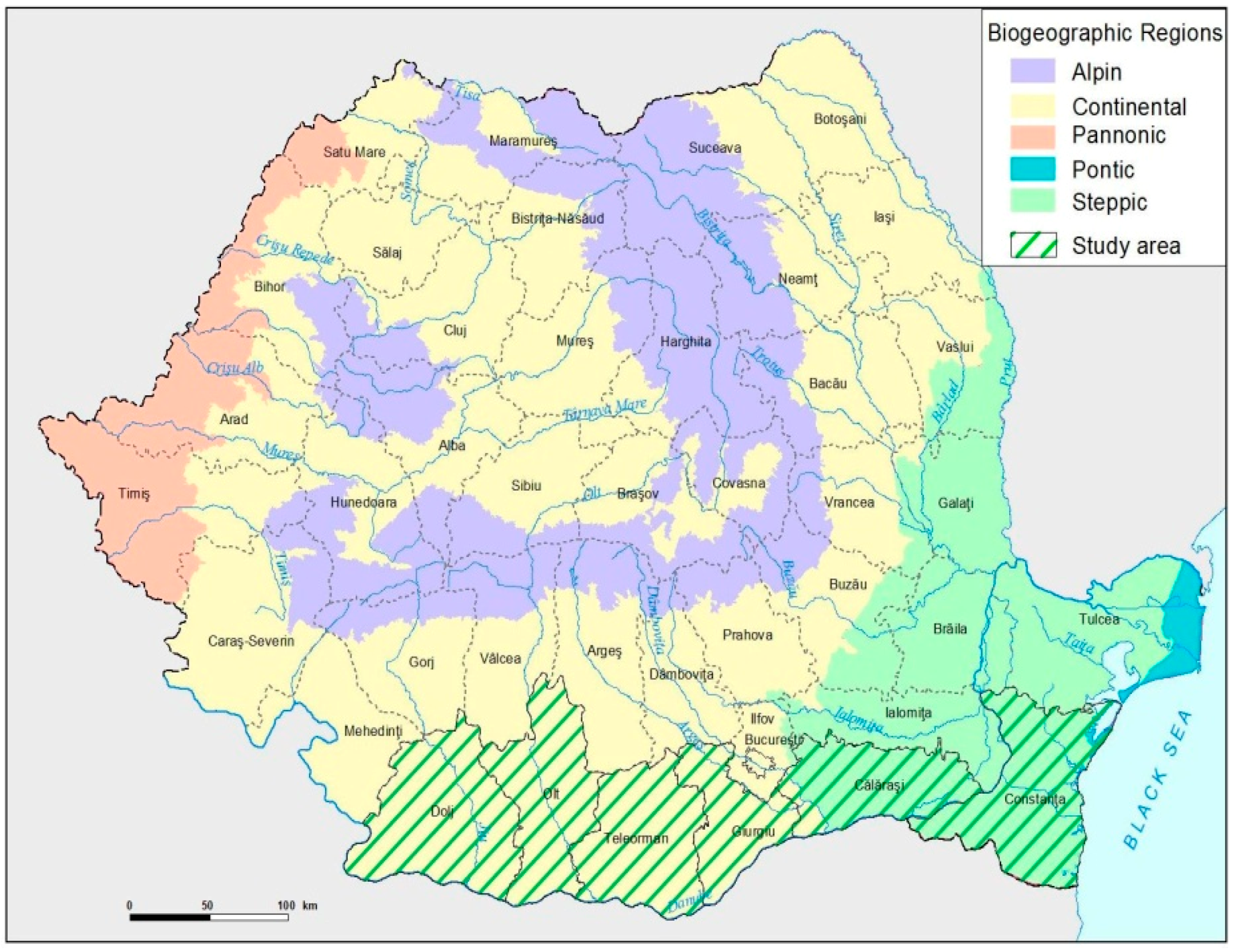

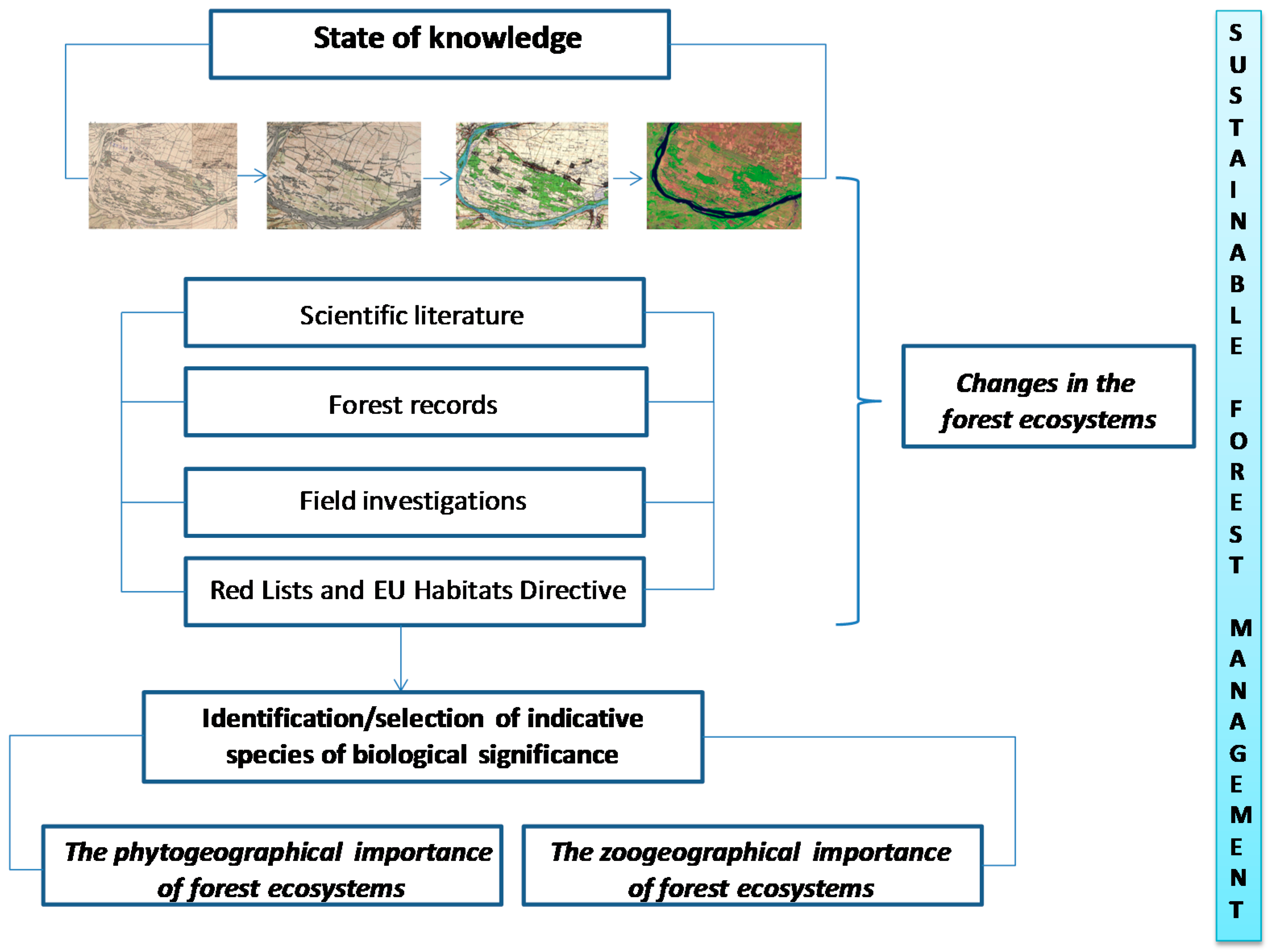
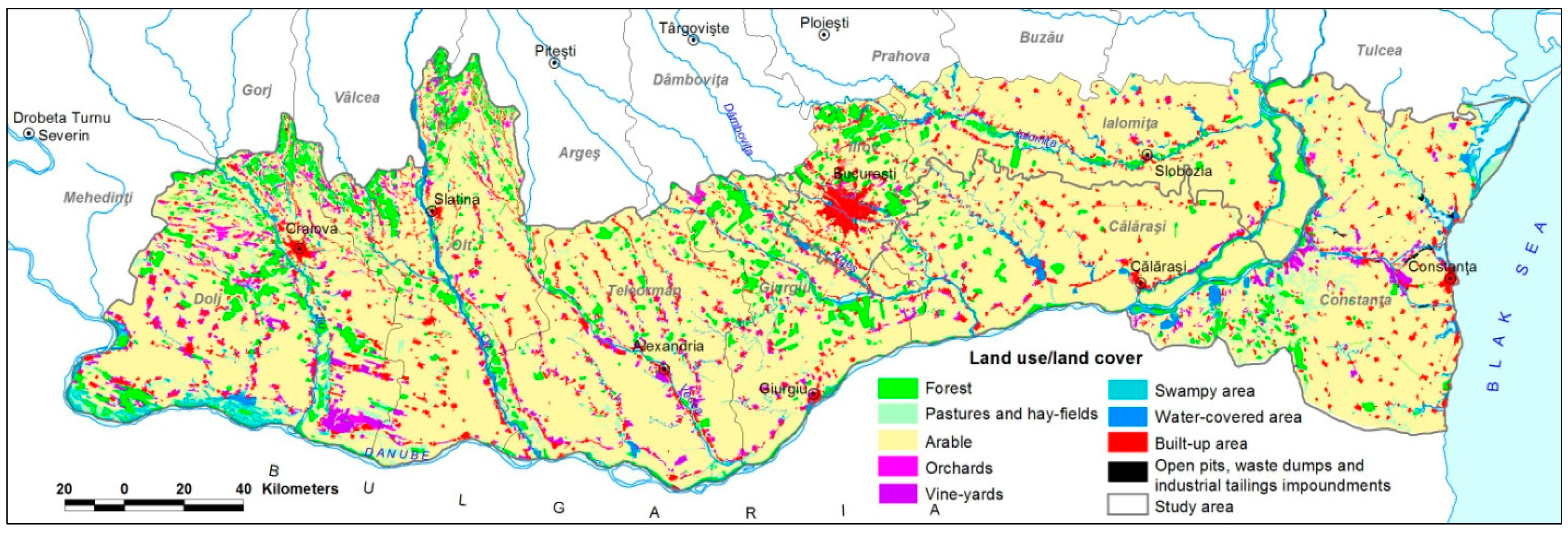
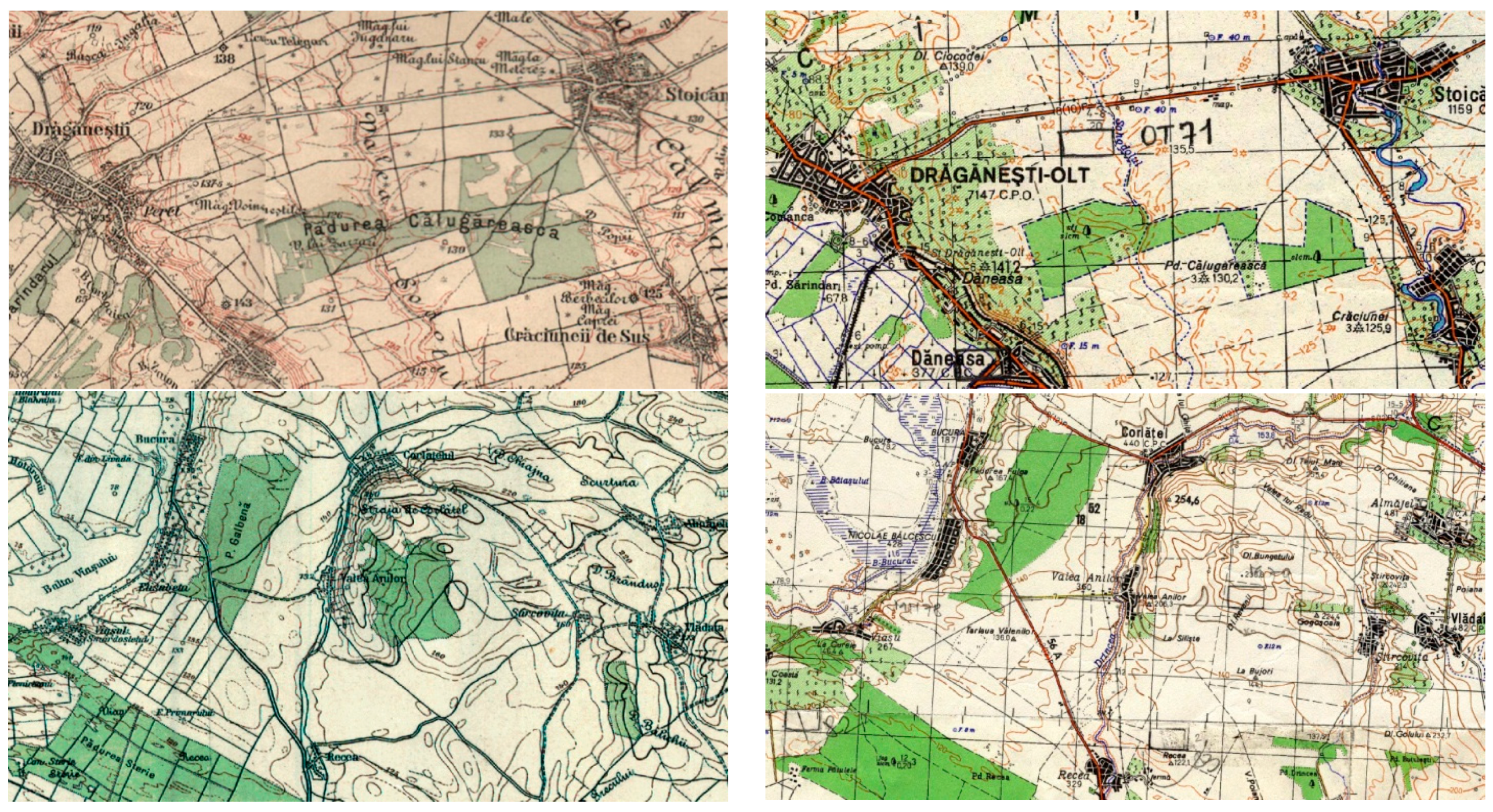

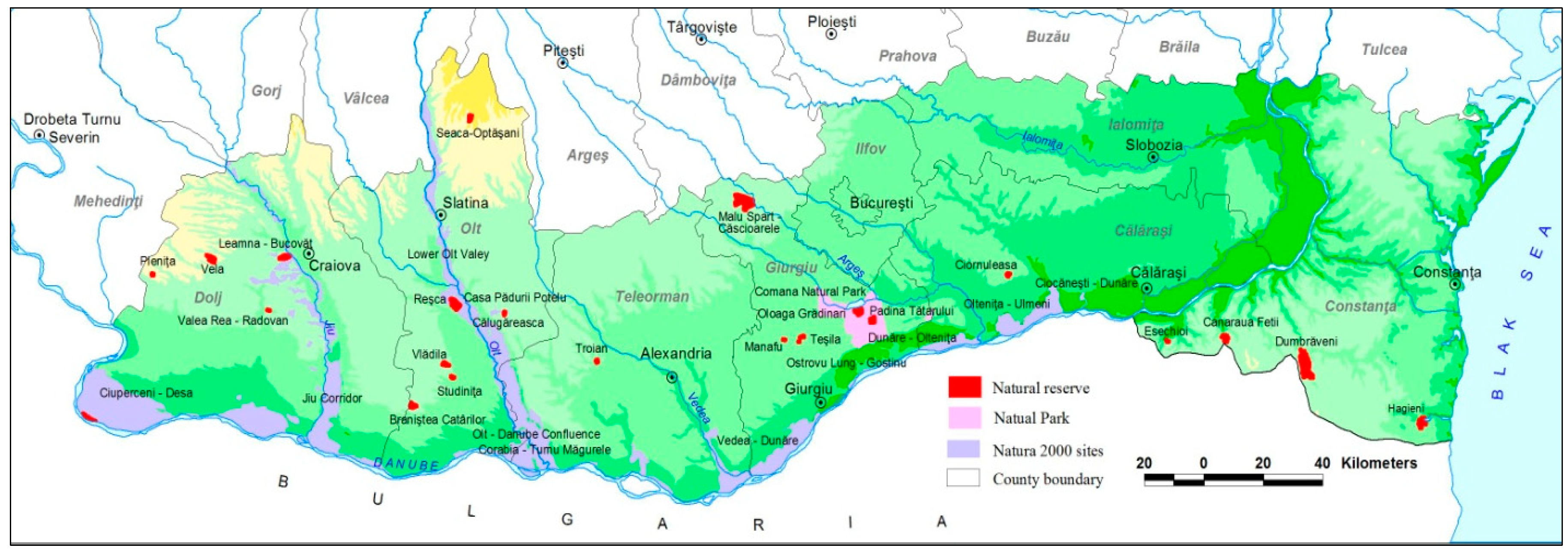
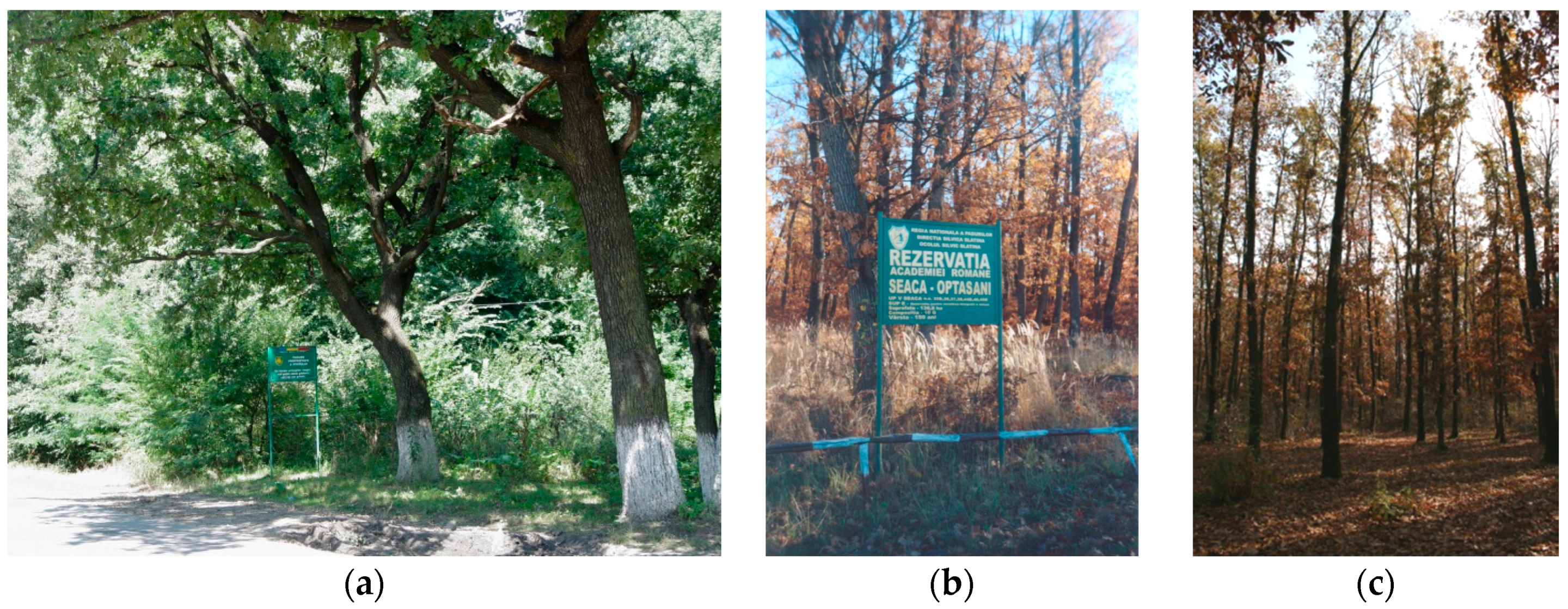
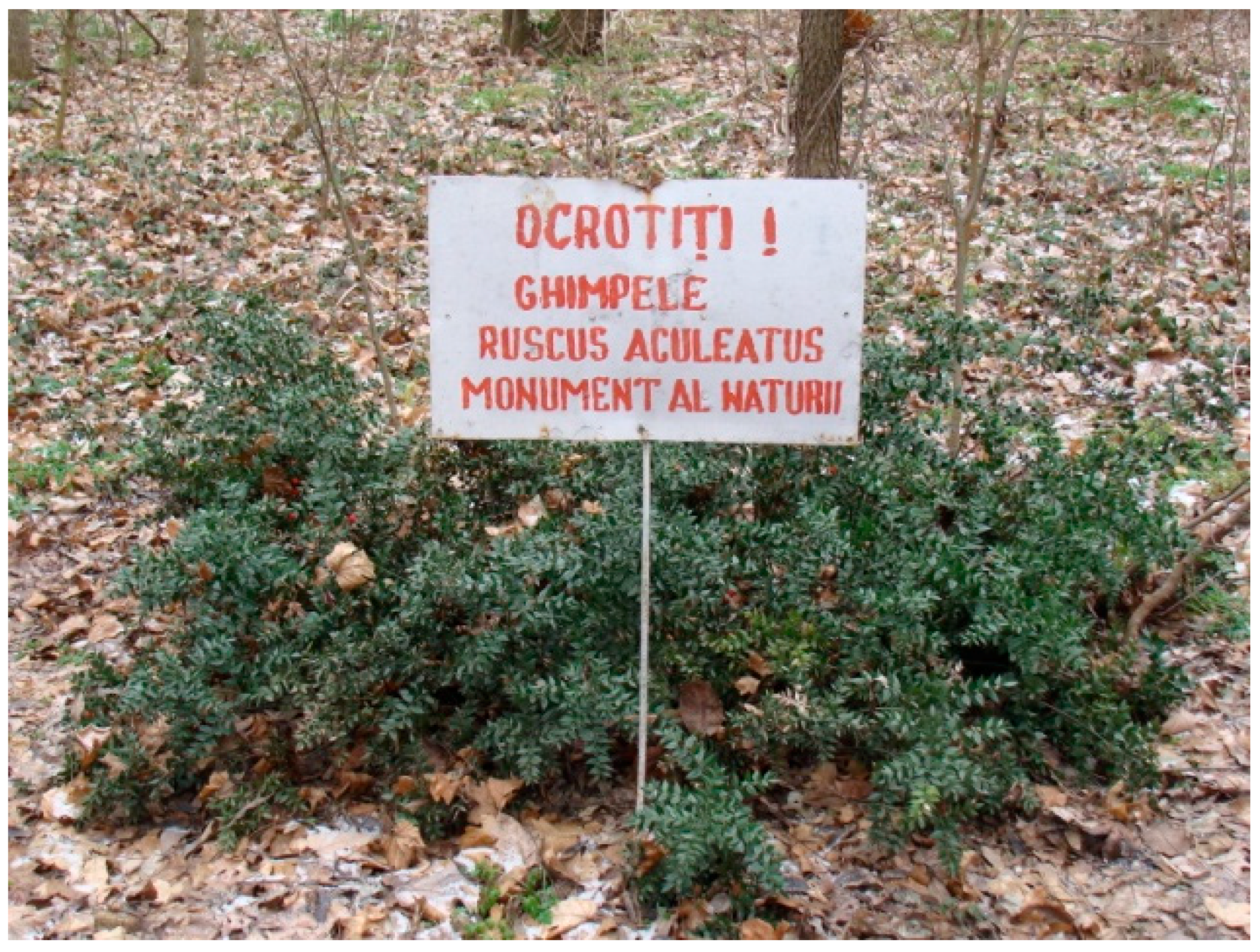
© 2018 by the authors. Licensee MDPI, Basel, Switzerland. This article is an open access article distributed under the terms and conditions of the Creative Commons Attribution (CC BY) license (http://creativecommons.org/licenses/by/4.0/).
Share and Cite
Geacu, S.; Dumitraşcu, M.; Grigorescu, I. On the Biogeographical Significance of Protected Forest Areas in Southern Romania. Sustainability 2018, 10, 2282. https://doi.org/10.3390/su10072282
Geacu S, Dumitraşcu M, Grigorescu I. On the Biogeographical Significance of Protected Forest Areas in Southern Romania. Sustainability. 2018; 10(7):2282. https://doi.org/10.3390/su10072282
Chicago/Turabian StyleGeacu, Sorin, Monica Dumitraşcu, and Ines Grigorescu. 2018. "On the Biogeographical Significance of Protected Forest Areas in Southern Romania" Sustainability 10, no. 7: 2282. https://doi.org/10.3390/su10072282
APA StyleGeacu, S., Dumitraşcu, M., & Grigorescu, I. (2018). On the Biogeographical Significance of Protected Forest Areas in Southern Romania. Sustainability, 10(7), 2282. https://doi.org/10.3390/su10072282






